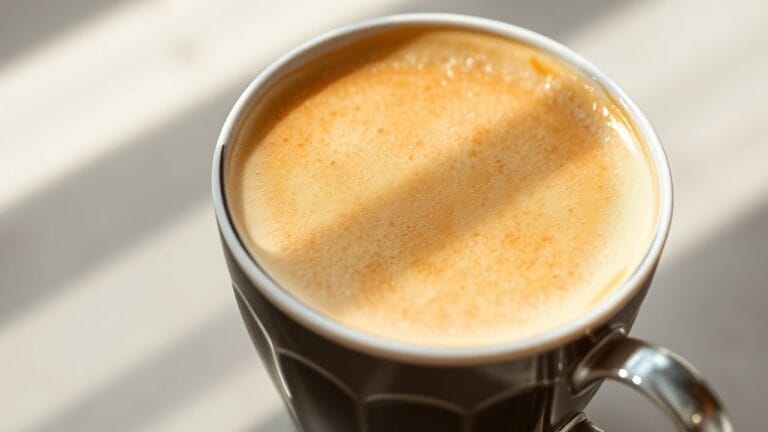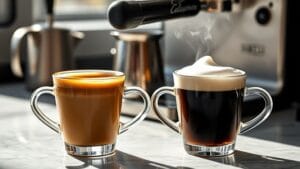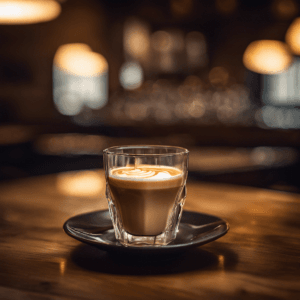A cappuccino typically has 63–126 mg of caffeine, varying by espresso shots, beans, and size. A single shot (1 oz) packs 40–80 mg, while larger drinks might use two or three shots. Beans matter: Arabica has less caffeine than Robusta. For comparison, a 12 oz cappuccino has about 75 mg, while a same-sized latte might hit 155 mg. Milk and foam add creaminess, not caffeine. Stick to one or two to avoid jitters. Curious about customizing your caffeine fix? There’s more to investigate below!
Caffeine Content in Cappuccino: Shots and Serving Sizes
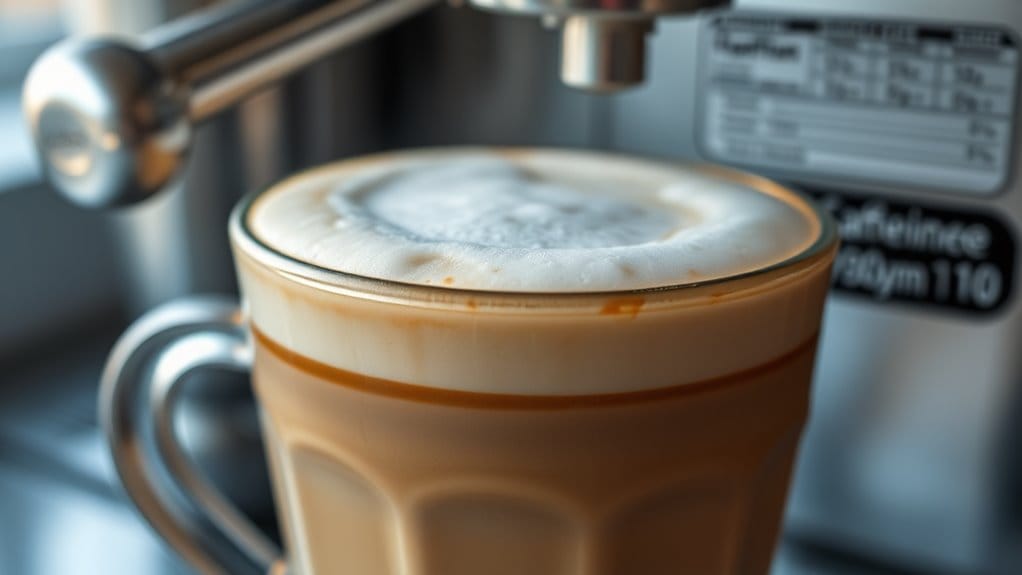
While a cappuccino might look like a cozy cloud of milk, its caffeine punch boils down to espresso shots and cup size. Traditional cappuccino sizes stick to a single espresso shot (40–80 mg caffeine) in a small 5–6 oz cup, but many coffee shops now serve 8–12 oz cups with two shots, doubling the kick. Notably, the drink’s origin traces back to Italian monasteries, where its color matched the brown hoods of Capuchin friars. The amount of caffeine in a cappuccino is also influenced by the bean type used to make the espresso shots. Want to go big? Some large sizes pack three shots—hello, 240 mg buzz! Espresso variations, like bean type or roast, stretch the caffeine range further, while extraction time or pressure tweaks intensity. Sippers craving freedom can customize shots or sizes—just ask the barista. Though bigger drinks add milk, caffeine stays tied to shots: a 12 oz drink with two shots holds the same caffeine per ounce as its smaller sibling. Understanding daily limits is essential to avoid adverse effects, such as insomnia and heart palpitations, and to ensure a safe and enjoyable coffee experience. Jitters optional!
Cappuccino vs. Other Drinks: Comparing Caffeine Levels
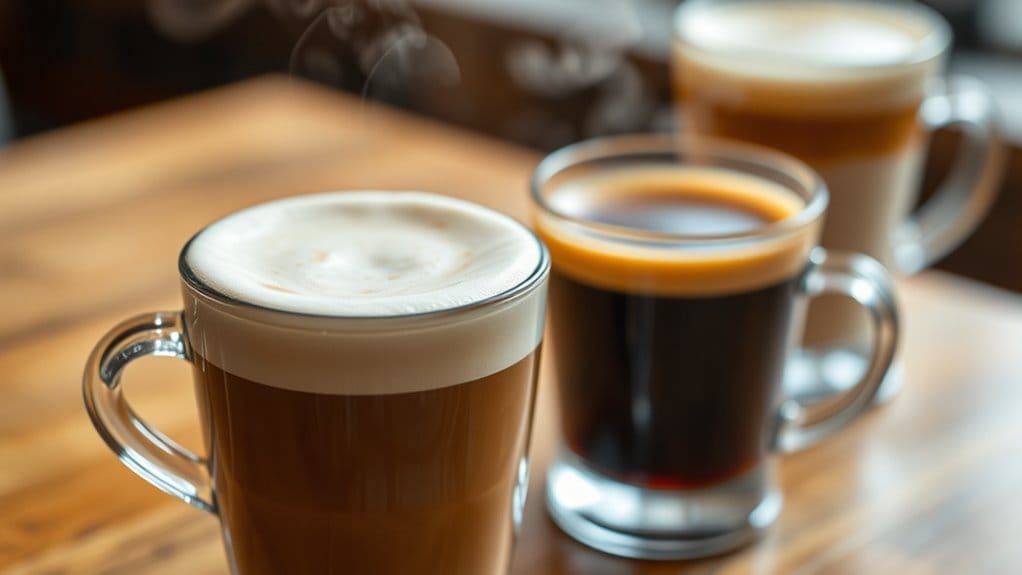
Cappuccino’s caffeine story doesn’t end with shots and cup sizes—it gets wilder when compared to other coffee drinks. A 12-ounce cappuccino has roughly 75 mg of caffeine, but its latte twin packs double (155 mg), all because lattes pour in more milk and less foam, stretching caffeine per sip. The type of coffee bean, such as Arabica beans, can also impact the overall caffeine content of a cappuccino.
Sizes matter: a 16-ounce cappuccino matches a same-sized latte’s 173 mg, proving espresso rules caffeine content, not cappuccino flavors or creamy textures. Italian morning tradition keeps cappuccino consumption strictly breakfast-centric, contrasting lattes’ all-day appeal. The brewing technique, including coffee roast, plays a significant role in determining the flavor and caffeine content of the espresso shot used in cappuccinos.
Drip coffee? It’s a rebel—it can flex stronger caffeine kicks or weaker sips, depending on how it’s brewed, sometimes out-caffeinating cappuccinos.
Even within the espresso family, a macchiato’s tiny milk splash won’t hide its bold shot, while flat whites stealthily rival cappuccinos caffeine-wise, using similar espresso but smoother texture.
Milk’s just the espresso’s caffeinated sidekick, folks—it tweaks taste, not the buzz. Choose battles based on flavor and foam, not jitters.
Factors Influencing Cappuccino’s Caffeine Concentration
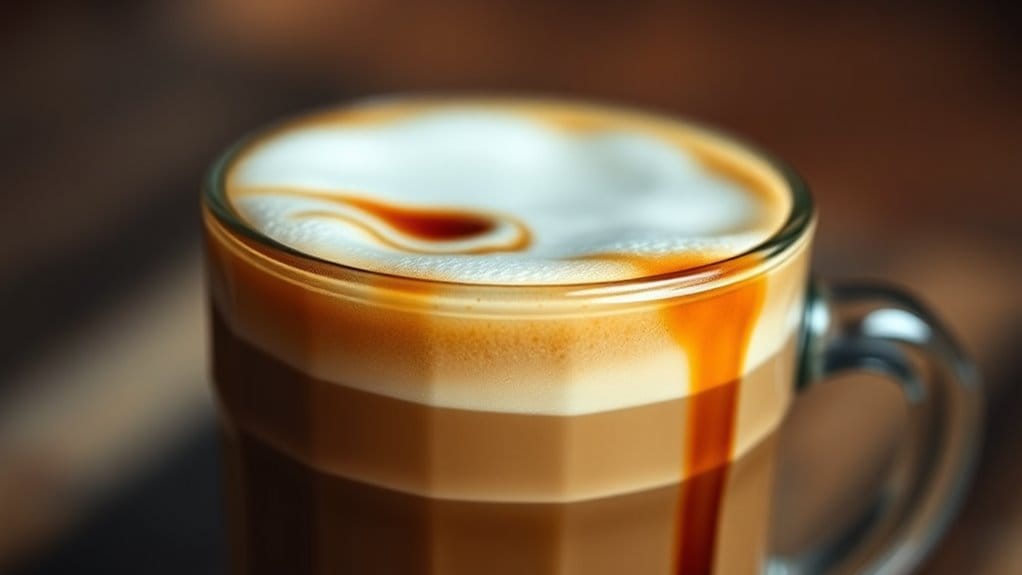
Whether you’re sipping a cozy morning brew or a mid-day pick-me-up, the caffeine in your cappuccino isn’t just about the espresso shot—it’s a mix of science and barista magic!
Coffee bean types play a huge role: Arabica beans pack 1.5% caffeine, while Robusta doubles that! How beans are roasted and processed affects caffeine too—lighter roasts keep more caffeine.
Brewing methods matter: espresso machines, timing, and pressure influence caffeine extraction. A longer brew time pulls more caffeine, but only genius-level baristas balance flavor and kick.
Even your machine’s quality or the grind’s fineness tweaks the result. The ideal roast level, such as medium roast, can also bring out the best flavor in a cappuccino. So, whether you’re a Robusta rebel or an Arabica aficionado, every sip’s caffeine depends on beans, brewing tricks, and a dash of caffeinated chemistry!
The ideal crema formation is also influenced by the type of coffee beans and roast levels, which in turn affects the overall caffeine concentration in a cappuccino.
Frequently Asked Questions
Does Coffee Brand Affect Caffeine Levels in Cappuccinos?
Coffee brand impacts cappuccino caffeine levels through coffee strength and bean origin. Robusta beans, higher in caffeine than Arabica, and brewing techniques altering espresso potency create variations. Blends balance flavor and stimulant content, shaped by regional or brand practices.
Can Alternative Milks Reduce a Cappuccino’S Caffeine Content?
Like rivers altering landscapes without moving mountains, alternative milk types reshape texture and taste but cannot erode caffeine in cappuccinos. Sensitivity lies within perception, as espresso’s essence persists—unchained by milk’s fluid metamorphosis.
Are There Caffeine-Free Options for Cappuccinos?
Caffeine-free cappuccino options include decaffeinated espresso shots containing trace amounts and flavorful alternatives like herbal brews or plant-based substitutes, providing texture-focused beverages for those desiring freedom from caffeine while maintaining traditional preparation elements.
Do Stirred vs. Layered Cappuccinos Vary in Caffeine?
Like diverging rivers reaching the same sea, stirred recipes and layered effects in cappuccino preparation yield identical caffeine levels, determined solely by espresso quantity rather than milk arrangement. The bean’s essence remains unchanged ultimately.
How Does Caffeine in Iced Cappuccinos Compare to Hot?
Espresso-based brewing methods create equivalent caffeine levels in iced and hot cappuccinos when shot counts match. Ice dilution might slightly lower concentration per volume, but total caffeine remains comparable unless altered by serving size adjustments.
References
- https://victorallen.com/blogs/blog/caffeine-in-a-cappuccino
- https://www.caffeineinformer.com/caffeine-content/cappuccino
- https://coffeebros.com/blogs/coffee/cappuccino-vs-latte
- https://cornercoffeestore.com/does-cappuccino-have-caffeine/
- https://majestycoffee.com/blogs/posts/cappuccino-vs-latte-caffeine
- https://www.javapresse.com/blogs/enjoying-coffee/debunking-myths-the-real-caffeine-content-of-cappuccinos
- https://coffeednyc.com/does-a-cappuccino-have-caffeine-comparing-cappuccino-and-coffee-caffeine-content/
- https://therestaurantauthority.com/blogs/news/what-has-more-caffeine-coffee-or-cappuccino
- https://www.masterclass.com/articles/cappuccino-vs-coffee
- https://www.drlisawatson.com/wp-content/uploads/2011/04/Caffeine-Chart4.pdf

